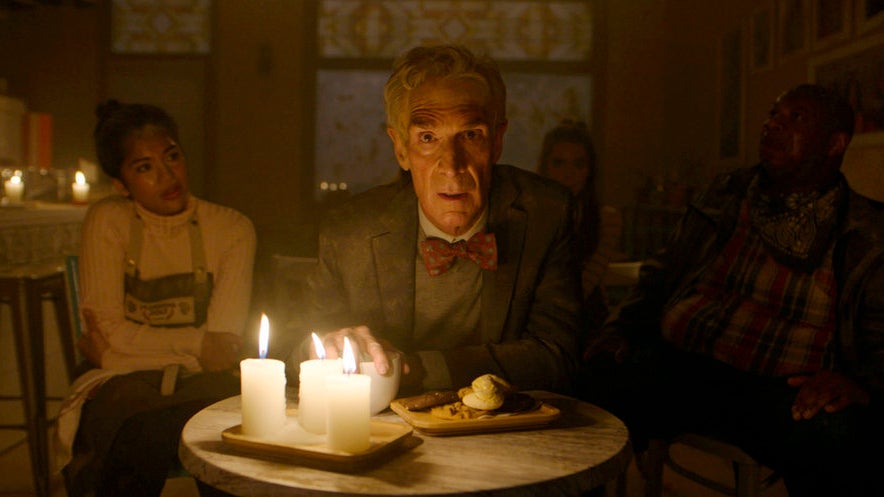“The End is Nye,” but it doesn’t have to be
Bill Nye speaks to the camera with other survivors of the apocalypse seated around him. “The End is Nye,” stars Bill Nye as he walks the audience through six different apocalypses, and is streaming on Peacock.
Bill Nye, seated in a plane heading straight into a massive storm, stares straight into the camera. Yet, other than Nye, no one on the plane knows they’re about to die. He then poses a rhetorical question to the audience, “Why is it that every disaster movie begins with someone in power ignoring a scientist?”
Since Nye’s Emmy-winning show, “Bill Nye the Science Guy” ended in 1998, Nye has been a massive advocate for not only listening to science but presenting it in an accessible way. Nye’s new show, “The End is Nye,” which ended August 25, does exactly that as Nye calmly narrates six different apocalypses that may be imminent and destroy life on Earth as we know it. What drew kids to his old television series is precisely what makes his newest show effective. His particular brand of education and entertainment, combined with the nostalgia of watching Nye’s animated personality, makes the audience want to listen to Nye — to take his warnings to heart.
As someone who grew up watching Nye’s videos in elementary school science classes, seeing his familiar face instantly evokes strong feelings of nostalgia. Gone are his old lab coats and curly brown hair. In their place, Nye wears pressed suits and disaster gear with, of course, his signature colorful bow tie. The gray streaks through his hair are a reminder of the years that passed, but the sparkle in his eyes as he talks about science has not changed at all. And while the new theme song pales in comparison to the iconic “Science Guy” song and graphics, the smooth cadence and inflection of Nye’s voice feel like revisiting childhood — a childhood filled with fire and brimstone.
As an omniscient narrator, he avoids being overly preachy while not shying away from pointing out bad decisions and systematic problems our society faces. In each episode, he focuses on how the apocalypse could play out from three first-person perspectives. From a scientist, an astronaut, to a soon-to-be bride, the emotional performances of these repeat actors ground the show and raise the stakes.
Surprisingly, the show also contains moments of dark humor, with Nye graphically dying in multiple ways. However, the shock of seeing his death barely registers before he nonchalantly wakes up to explain exactly how this event threatens the viewers’ lives. Watching the death of your childhood hero is undoubtedly an effective wake-up call, especially when it is later clear that these deaths are entirely preventable.
However, where this show really shines is in its neatly packaged call-to-actions. In the latter half of each episode, Nye returns to his secret lab and teaches the audience the science behind each disaster and exactly how likely each apocalypse is to happen. (Spoiler alert: very likely) But throughout his explanations, he provides solutions. Nye passionately implores the audience to take action, to prevent these apocalypses from ever happening. He masterfully breaks down complex problems into simple, actionable steps that seem so reasonable it makes the audience question why they haven’t already been implemented.
And here is where the real genius of this show lies — it provides hope. News and science often focus on problems in a way that makes them feel insurmountable, like the fight is over before it has even started. Even though the way Nye explains each solution is an oversimplification of a much more complex issue, his show offers a unique ray of light that the answers to these disasters are entirely within our grasp.
To answer Nye’s question about why disaster movies all start with people ignoring scientists, perhaps it is because it happens all too often in real life. But it is refreshingly clear that this series is not a disaster show; it’s a science show. The mindset the show uses to attack each disaster is one of the solutions and next steps. So perhaps a more accurate title for the show would be: the end is Nye, but it doesn’t have to be.




